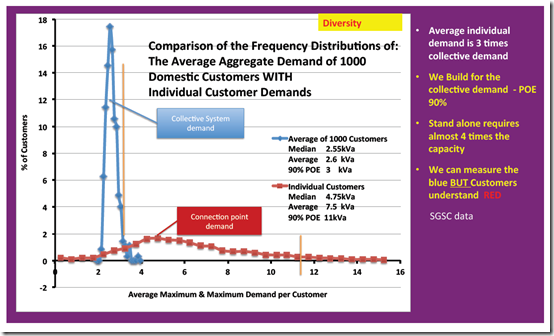Much time and effort is currently going into the development of home energy management systems, one of the objectives of which is to enable the customer to “smooth his electricity demand” by switching appliances on or off so as to reduce his maximum demand.
Whilst this is seen as desirable, in that it purports to reduce the customer’s requirement for electricity network capacity, much of the effort is in fact counterproductive. Only switching actions, which genuinely shift customer load entirely away from periods of likely network maximum demand, contribute positively to network economics. Switching actions which merely smooth the customer’s load do not.
The reason for this counterintuitive outcome is that networks are not built to meet the individual demand of individual customers but are in fact built to meet the collective demand of groups of customers. And when the collective demands of individual customers are aggregated, the random variations between customers automatically sum to zero.
Typically the average demand of a collective group of domestic customers will be @ 1/3rd of their individual maximum demands.
At the collective level it is therefore only the customers underlying (or systemic) load pattern that matters.
Here it is important to distinguish between the purely random and the systemic variations between customer load profiles. There is no point in managing a customer’s purely random variations down to zero, thereby reducing his demand to one third, if the result is that all the customers in the collective end up with similarly smoothed load profiles, with no random variation. Having destroyed random variation, the sum of the collective demand will be the same, as if no Demand management had been undertaken. Nothing will have been achieved.
However if Demand Management is aimed at changing the customers underlying load profile, by shifting demand entirely away from times of likely network maximum demand, then that is a constructive outcome. However it too has its pitfalls.
A great deal depends upon whether the future for network tariffs is:
Time of Use Demand, Time of Use Energy or, Controlled Load tariffs (see note below)
Option 1 = Time of Use Demand Tariffs
Whist Time of Use Demand Tariffs will provide some incentive for customers to shift demand entirely away from peak periods, their main incentive will be for customers to simply smooth their demand (as this will achieve the greatest and easiest reduction in the metric they are charged for).
Time of Use Demand Tariffs will thus likely create a market for load management systems, which deliver little or no benefit for the network, with potential loss of amenity for the customers.
Option 2 = Time of Use Energy Tariffs
Time of Use Energy Tariffs, on the other hand, provide no incentive to smooth demand throughout periods of potential peak demand but do provide strong incentive to shift demand entirely away from the peak periods.
The problem with these tariffs is that, whilst the process of aggregation during the peak periods will continue to “average out” purely random variations, the incentive of cheaper prices at the end of the peak period will incentivize synchronized “switching on” of appliances by customers at the “price break time”. The natural random variation between these loads will be destroyed and “artificial” network peaks created.
Appropriately priced intermediate or shoulder charges go only part way towards addressing this.
Editor’s Note
Here’s a prior article highlighting what can happen on the energy market side if significant load returns at these “price break times”.
Option 3 = Controlled Load Tariffs
The industry has traditionally offered customers “Controlled Load Tariffs”.
The advantage of controlled load arrangements is that they enable the distribution business to engineer variation into switching times, thereby creating artificial load variability, thus enabling the sculpturing of the collective load profile so as to optimally match network capacity.
Differences between the 3 Options
The load management technologies of these three approaches, whilst having many common features, are fundamentally different.
At one extreme, there is the technology required for continuous real time management of a full myriad of customer; IP addressable, appliances such as is advocated by IT and Communications Industry interests (with its potential for “Big Data” processing requirements).
At the other extreme there is the relatively simple minimalist technology required to remotely control, a limited number of significant high load appliances, which either have no timing imperative (such as pool pumps) or which have within them inherent energy storage capacity (such as storage hot water heaters and electric vehicles).
From a network management perspective investment in Option 1 is unlikely to achieve any better an outcome than (or indeed as good an outcome as) investment in Option 3 – other than, perhaps the perception of “greater customer choice”.
That is not to say that there are not other potentially worthwhile benefits from investing in Option 1. Customer home energy management systems that enable customers to conserve energy, offer the convenience of automatically anticipating customer needs, or which offer energy trading benefits may be sufficiently valued by customers to warrant such investment.
However it is important not to attribute network economic benefits to such investments, if those benefits can be more effectively delivered in alternative minimalist ways.
Notes about the Three Tariff Options
Energy-Only tariffs charge customers for their aggregate energy consumption (kWh), during the billing period, whereas Demand Tariffs charge customers for their maximum demand (or peak rate of energy consumption (kW or kVa)).
Controlled Load Tariffs charge customers lower prices for energy supplied, to selected appliances, at times which are controlled by the Distribution business (normally off peak times), but which remain unsupplied at all other times (normally peak times).
Time of Use (ToU) tariffs (both energy only and demand) charge customers different rates at different times – normally higher rates at peak times and lower rates at off peak times. An intermediate, or shoulder charge, also usually applies.
About our Guest Author
| Mervyn is a career engineer, engineering consultant and professional company director.
He has extensive experience in the electricity distribution industry. After more than 30 years in a range of operational and management positions with EnergyAustralia (now AusGrid), including as General Manager Network and a brief period as Managing Director, Mervyn established and operates an engineering consultancy practice which specialises in engineering management and the economics of electricity distribution networks. He has also served on many state and private energy boards. These include EnergyAustralia (now AusGrid) in NSW, Country Energy (now Essential Energy) in NSW, Western Power Corporation (WA), Aurora Energy Pty Ltd (Tasmania) and New World Energy Pty Limited. He is currently a director of the Northern Territory Power & Water Corporation (NT), TasNetworks (Tasmania) and Energex (Qld.). Mervyn holds both Honours and Masters degrees in Engineering and a Bachelor of Commerce (Economics). He has a Membership / affiliation with The Warren Centre – Energy Committee (University of Sydney), the Electric Energy Society of Australia and, is a Fellow of the Australian Institute of Energy. You can find Mervyn on LinkedIn here. |




Thanks Mervyn.
What’s the process of engineering variation into switching times?
How would you propose that SA’s controlled load peak (sometimes the daily peak load), be flattened?